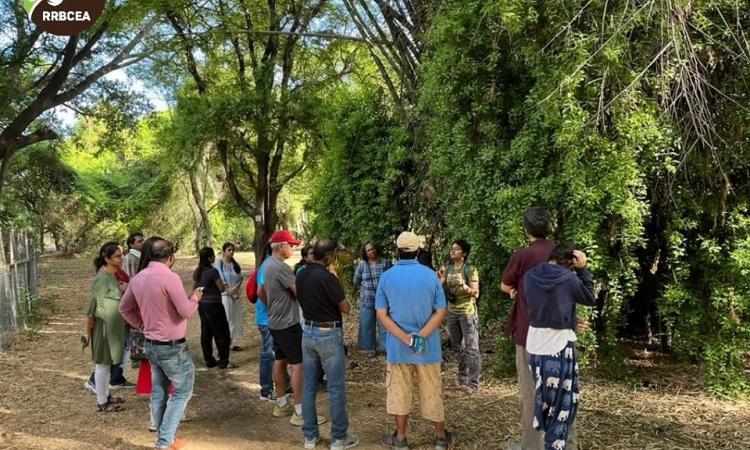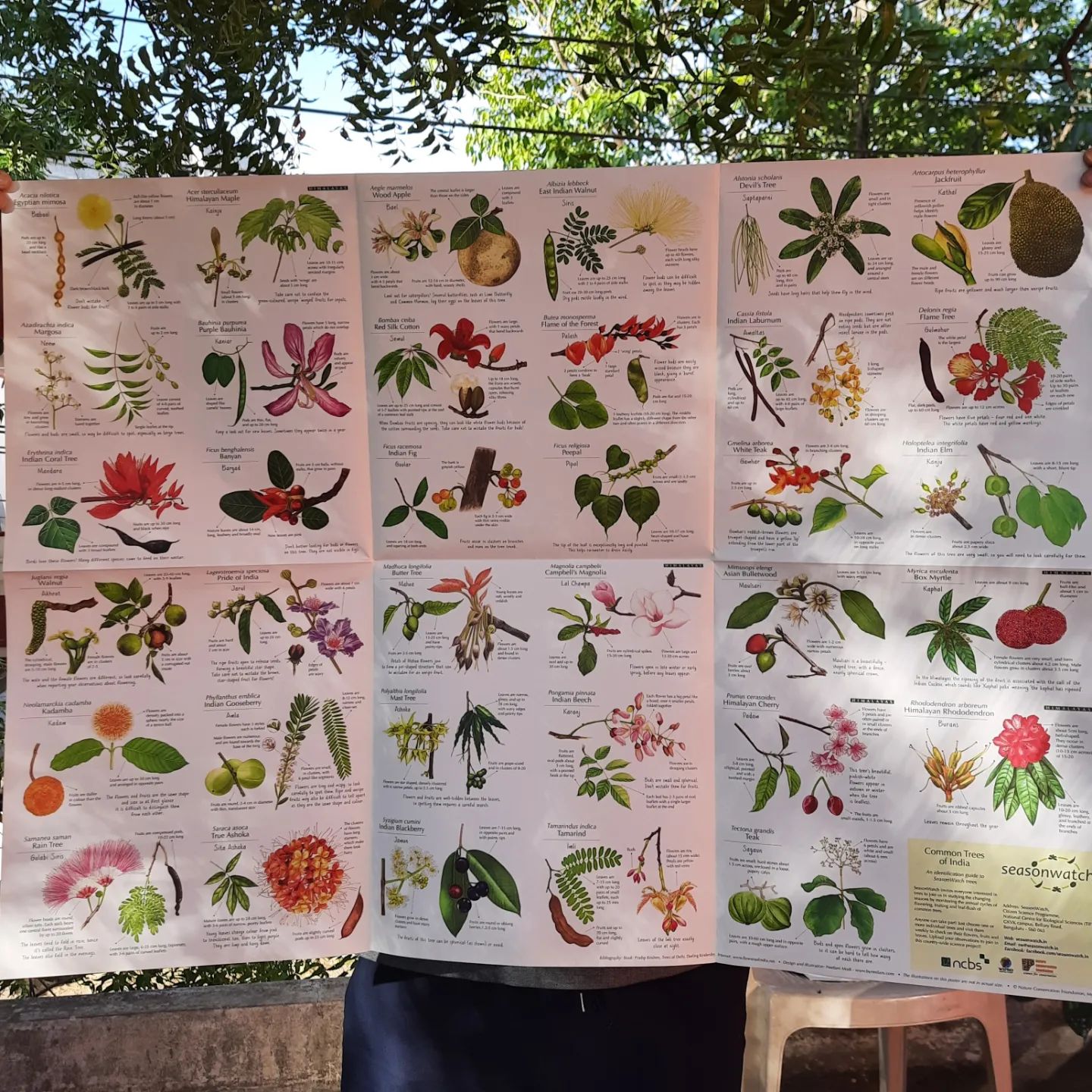
In the heart of India, amid the bustling sounds of city life and the tranquil whispers of rural landscapes, a citizen science project has been developing over the last decade. The Nature Conservation Foundation (NCF), known for its dedication to ecological research and conservation, envisioned a unique project, named SeasonWatch, aimed to harness the power of ordinary citizens to observe extraordinary changes in nature.
The founders of SeasonWatch were driven by a singular belief: that the profound impacts of climate change on India's trees could be observed and documented by anyone, from school children to retirees. Trees, those silent witnesses to the passage of time, were beginning to alter their rhythms. Leaves unfurled at unexpected times, flowers bloomed out of season, and fruits ripened unpredictably.
“These phenological changes—driven by shifts in temperature, rainfall, and other climatic factors—hold crucial clues about the health of our planet,” says Geetha Ramaswami, Project Lead now at SeasonWatch. She has been looking at the effects of seasons on tree phenology, as a part of the project since March 2018.
The project began in the state of Kerala, where it quickly captured the imaginations of students and teachers. Schools that got engaged with SeasonWatch became vibrant hubs of activity as children were encouraged to step outside and observe the trees around them. With notebooks in hand, they recorded when leaves budded, flowers blossomed, and fruits appeared. Every observation was a tiny piece of a larger puzzle, contributing to a growing database that scientists could use to track the impacts of climate change.
As SeasonWatch's success in Kerala grew, so did its ambitions. The team at the Nature Conservation Foundation, fuelled by their passion and the encouraging results, decided to expand the project to Maharashtra and Tamil Nadu. These states are selected due to their ecological diversity and existing interest in nature conservation.
The project targets residents aged 12 and above, particularly school children, university students, educators, and nature enthusiasts. The rationale for this demographic is the ease of learning tree observation protocols and the broad cultural and ecological importance of the selected tree species. This expansion to newer states would require meticulous planning, more resources, and most importantly, the enthusiastic participation of even more citizens.
The journey was not without its challenges. Climate change, a vast and complex problem, often seemed too overwhelming for the average person to grasp. Yet, the SeasonWatch team was undeterred. They knew that personal engagement with nature was the key to fostering a deeper understanding of climate issues.
To bridge this gap, they organised workshops and training sessions, teaching participants how to accurately observe and record phenological changes. They reached out to schools, universities, and local communities, spreading their message through social media and print. Every new participant was a victory, every new observation a step closer to understanding how climate change was affecting India's biodiversity. Incorporating climate change education into school curriculum could foster an early connection with nature.

As the project expanded, it began to weave a rich tapestry of stories. As a part of SeasonWatch, many experts and citizens have highlighted the unique connection they feel with plants and their appreciation for its role in their life.
For example, Aditi Vijayan in a blog post reflects on her special bond with a curry leaf tree (Murraya koenigii) from her teenage years. The tree, which she affectionately named Murraya, was her confidant and a source of comfort. She shares how she discovered and dealt with a caterpillar infestation on the tree, which eventually led her to a deeper interest in insects and their behaviour. This early experience with Murraya helped shape her career path, leading her to study neurobiology and pest behaviour.
In the bustling city of Mumbai in Maharashtra, a young botanist Sayee Giridhari, who is also a Project Coordinator at SeasonWatch shares her lifelong love of trees with a group of enthusiasts, guiding them through the local park and explaining the significance of each observation.
These stories were not just about data; they were about connection. SeasonWatch was creating a community of nature lovers who were not just passive observers but active contributors to scientific knowledge. Each participant, regardless of age or background, became part of a larger narrative—one that spanned across regions and generations, bound by a common purpose. SeasonWatch organises online workshops for beginners to learn and revise the basics of tree identification and tools to engage with trees.
The role of technology
To support this growing community, the SeasonWatch team knew they needed to harness the power of technology. They developed an app and an easy-to-navigate website, allowing participants to upload their observations in real time. The app was designed to be user-friendly. In future, SeasonWatch plans to incorporate it with features like AI-assisted species identification and phenological stage recognition, making it accessible to everyone.
But technology was only part of the solution. The heart of SeasonWatch lay in its human connections—in the teachers who incorporated it into their curriculum, the parents who explored nature with their children, and the individuals who found a renewed sense of purpose in observing the natural world.
The impact of SeasonWatch was evident not just in the data collected but in the lives it touched. Schools reported increased engagement in science classes, as students were no longer just learning from textbooks but from the world around them. Communities came together for tree walks and festivals, celebrating the beauty and importance of their local flora.
In the scientific community, the data gathered by SeasonWatch participants became a valuable resource. Researchers used it to analyse patterns and trends, gaining insights into how climate change was affecting different tree species across India. This information was crucial for developing strategies to protect and conserve the country’s rich biodiversity.
As SeasonWatch looked to the future, its vision only grew bolder. The project aims to expand to new regions, involving more schools, universities, and individual participants. They dream of a day when more and more citizens, no matter where they live, will feel empowered to contribute to the understanding and mitigation of climate change.
To achieve this, the team planned to develop multi-language support for their app and website, making it accessible to a broader audience. They have created multilingual, user-friendly resources such as tree identification guides and activity handbooks. They envision photo upload features and AI tools becoming even more sophisticated, helping participants make accurate and meaningful observations with ease.
SeasonWatch is more than just a project; it is a movement. It shows that collective action, driven by curiosity and a love for nature, can lead to profound change. By turning the abstract concept of climate change into a tangible experience, it empowers individuals to take ownership of their role in protecting the planet.
In every leaf bud, every blossoming flower, and every ripening fruit, the participants of SeasonWatch see the story of climate change unfolding. And through their observations, they were writing a new chapter—one of hope, resilience, and a shared commitment to preserving the beauty and diversity of nature for future generations.
The tale of SeasonWatch is a testament to the power of citizen science. It illustrates how ordinary people, united by a common goal, can contribute to extraordinary scientific achievements. As SeasonWatch continues to grow and evolve, it remains a beacon of hope, demonstrating that even in the face of daunting challenges like climate change, collective action and community engagement can lead to meaningful change. The trees of India, with their timeless cycles, have found new storytellers in the citizens who watch over them, ensuring that their stories—and the lessons they teach us—are never forgotten.
/articles/tale-seasonwatch-citizens-trees-and-climate-change